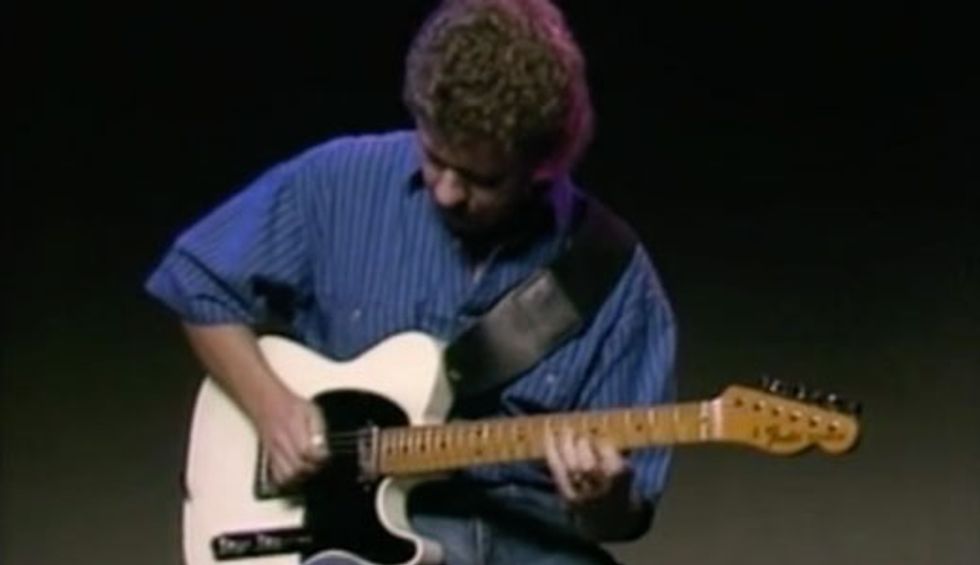Theory: Intermediate
Lesson Overview:
• Dive deep into hot-rod double-stops.
• Strengthen your CAGED vocabulary.
• Learn to outline chords using fast-moving intervals.
Click here to download a printable PDF of this lesson's notation.
Scotty Anderson is, without doubt, one of country guitar’s best-kept secrets. Despite having a long career in the business, releasing some great albums and videos, and playing out regularly, he’s largely unknown outside the Cincinnati music scene.
Anderson has a beautiful chord vocabulary that’s heavily inspired by pedal-steel voicings, amazing Travis-picking technique, a mastery of jazz harmony, and speed to die for. However, his blazing-fast double-stops are the most head-turning aspect of his playing.
Scotty Anderson isn’t just another country guitarist. Here, on Duke Ellington’s classic “Take the ‘A’ Train,” he demonstrates his deep knowledge of jazz vocabulary.
Harmonized leads in country music have been around for decades. Guitar greats Eldon Shamblin and Jimmy Bryant would often play harmonized solos with fiddle or steel players, and Jerry Reed’s “Eastbound and Down” has a memorable dual-guitar lead break. Scotty threw all of this out the window by becoming a one-man harmonizer.
I’ve recorded each of these examples using my Fender Telecaster with Joe Barden pickups and added some rather heavy compression to keep the double-stops even in volume.
To play this like Scotty, you’ll need to use a thumbpick and maintain a nail on the index finger to pluck the string adjacent to the one being played by the thumbpick. In Ex. 1, I’ve fretted notes on both the 4th and 3rd strings and attacked them using this technique. Use the pick on the 4th string and, as you pluck that string, use your index fingernail to pluck the 3rd string. The upstrokes (which occur in measures 2 and 4) are executed the same way, with the index fingernail plucking the 3rd string as the pick hits the 4th string with an upstroke.
Click here for Ex. 1
At this point, you might be considering giving up on this lesson. I don’t blame you—this double-stop technique is difficult to get right, especially at the speeds that Scotty plays. But there are other options: While it’s not ideal, you can play these double-stops with a flatpick. Because the notes aren’t attacked at exactly the same time, this will give you a slightly different sound, but it will get you close.
Another option is hybrid picking, where you use the flatpick and middle finger in a traditional pinching motion. This will severely hamper speed, but that’s not the end of the world because Scotty’s vocabulary is just as cool when played slowly. That’s actually how I do all these licks.
Ex. 2 is a simple single-note melody as played on “Boog’s Boogie.” This is played over an E chord using a flatpick and alternate picking.
Click here for Ex. 2
Next, let’s add a lower harmony to turn the melody into a double-stop groove (Ex. 3). As far as choosing the harmony notes for these double-stop ideas, there are no rules. Where a rock player might just play a fixed harmony three notes higher, Scotty’s harmonies are based on sound. Some notes will be a third apart, others a fourth. One approach is to think of the chord you’re playing over, and then use the major pentatonic scale as your palette, rather than the full seven-note major scale.
Click here for Ex. 3
To further illustrate this concept, here’s a fast-paced triplet lick (Ex. 4) using notes of the E minor pentatonic scale (E–G–A–B–D). This pentatonic approach was common in the Allman Brothers’ dual-guitar harmony, but here, you’re doing both parts on one guitar.
Click here for Ex. 4
Ex. 5 outlines an A7 chord, beginning in the “G” CAGED position and then shifting up through each CAGED position on the top three strings. It’s possible to analyze these 3-string chord patterns as C#dim, Em, and F#m, but in relation to the A chord you’re playing over, that yields an A7, A9, and A6 sound, respectively.
Click here for Ex. 5
Ex. 6 is a great ending lick for a tune in A. It begins with an E6 chord fretted higher up the neck. This shape descends chromatically before reaching an A chord in the “C” shape (measure three) and finally resolving to an A double-stop composed of notes found in the “E” shape even further down the fretboard.
Click here for Ex. 6
Ex. 7 outlines an E7 chord in the “C” shape. Here’s one way to analyze it: We begin by playing notes from the E major pentatonic scale (E–F#–G#–B–C#). Then starting in measure two, we add a chromatic approach to the 3 and 5 before walking down from an E double-stop on the 5th and 4th strings to a D double-stop. This closing “D against E” sound creates a strong E7 vibe.
Click here for Ex. 7
Ex. 8 also shifts between an open A position and a CAGED “E” shape A chord at the 5th fret, but now introduces some diatonic sixths on adjacent strings at the end, instead of the thirds and fourths we’ve played in the licks so far.
Click here for Ex. 8
The final lick (Ex. 9) outlines an E chord with chromatic double-stops a half-step below the chord tones. Beginning in the “C” shape, it quickly shifts up to the “A” shape before resolving to a pleasing sixth. It’s no accident that these notes are G# and E—they’re the 3 and root of the chord.
Click here for Ex. 9
With these licks, we’re just scratching the surface of what’s possible with this hot-rod double-stop style, and I would highly encourage you to check out Scotty’s first two albums on Bandcamp. These LPs were thought to be lost to time, but now you can check them out. If you add them to your library, all the money goes directly to the man himself.
All I’ll say is … hold on to your hat!
















